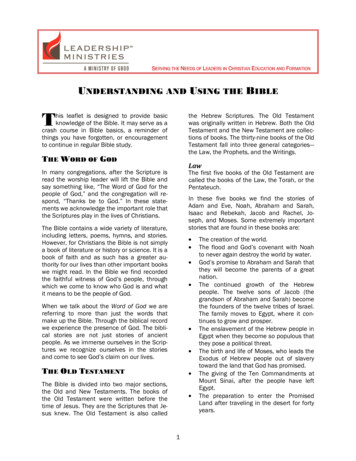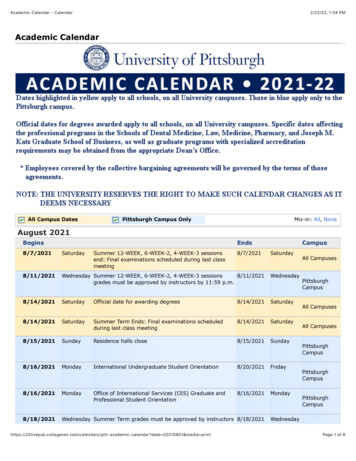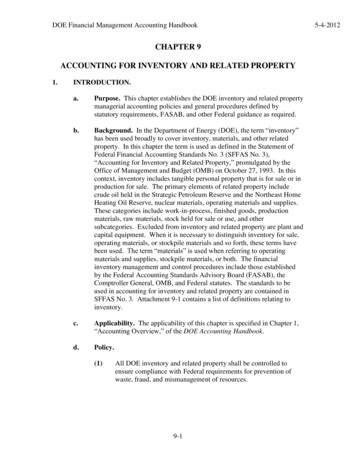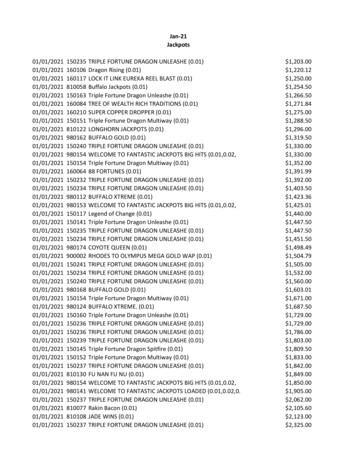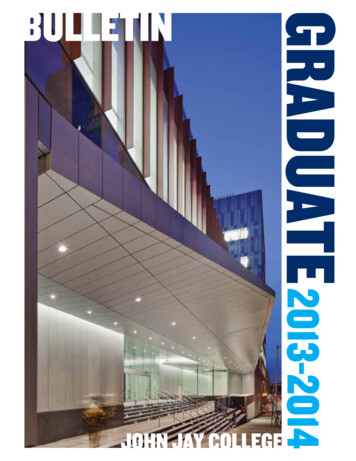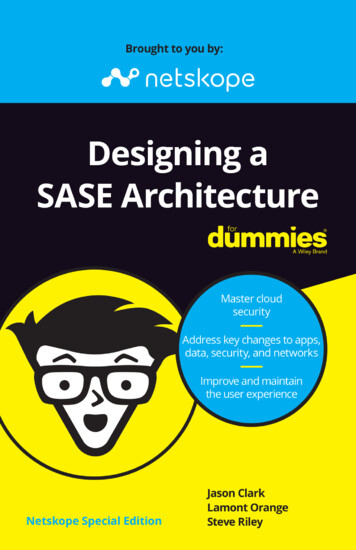
Transcription
These materials are 2021 John Wiley & Sons, Inc. Any dissemination, distribution, or unauthorized use is strictly prohibited.
Designing a SASEArchitectureNetskope Special Editionby Jason Clark, Lamont Orange,and Steve RileyThese materials are 2021 John Wiley & Sons, Inc. Any dissemination, distribution, or unauthorized use is strictly prohibited.
Designing a SASE Architecture For Dummies , Netskope SpecialEditionPublished byJohn Wiley & Sons, Inc.111 River St.Hoboken, NJ 07030-5774www.wiley.comCopyright 2021 by John Wiley & Sons, Inc., Hoboken, New JerseyNo part of this publication may be reproduced, stored in a retrieval system or transmitted in anyform or by any means, electronic, mechanical, photocopying, recording, scanning or otherwise,except as permitted under Sections 107 or 108 of the 1976 United States Copyright Act, withoutthe prior written permission of the Publisher. Requests to the Publisher for permission should beaddressed to the Permissions Department, John Wiley & Sons, Inc., 111 River Street, Hoboken, NJ07030, (201) 748-6011, fax (201) 748-6008, or online at http://www.wiley.com/go/permissions.Trademarks: Wiley, For Dummies, the Dummies Man logo, The Dummies Way, Dummies.com,Making Everything Easier, and related trade dress are trademarks or registered trademarks ofJohn Wiley & Sons, Inc. and/or its affiliates in the United States and other countries, and may not beused without written permission. All other trademarks are the property of their respective owners.John Wiley & Sons, Inc., is not associated with any product or vendor mentioned in this book.LIMIT OF LIABILITY/DISCLAIMER OF WARRANTY: THE PUBLISHER AND THE AUTHOR MAKE NOREPRESENTATIONS OR WARRANTIES WITH RESPECT TO THE ACCURACY OR COMPLETENESS OFTHE CONTENTS OF THIS WORK AND SPECIFICALLY DISCLAIM ALL WARRANTIES, INCLUDINGWITHOUT LIMITATION WARRANTIES OF FITNESS FOR A PARTICULAR PURPOSE. NO WARRANTYMAY BE CREATED OR EXTENDED BY SALES OR PROMOTIONAL MATERIALS. THE ADVICEAND STRATEGIES CONTAINED HEREIN MAY NOT BE SUITABLE FOR EVERY SITUATION. THISWORK IS SOLD WITH THE UNDERSTANDING THAT THE PUBLISHER IS NOT ENGAGED INRENDERING LEGAL, ACCOUNTING, OR OTHER PROFESSIONAL SERVICES. IF PROFESSIONALASSISTANCE IS REQUIRED, THE SERVICES OF A COMPETENT PROFESSIONAL PERSON SHOULD BESOUGHT. NEITHER THE PUBLISHER NOR THE AUTHOR SHALL BE LIABLE FOR DAMAGES ARISINGHEREFROM. THE FACT THAT AN ORGANIZATION OR WEBSITE IS REFERRED TO IN THIS WORKAS A CITATION AND/OR A POTENTIAL SOURCE OF FURTHER INFORMATION DOES NOT MEANTHAT THE AUTHOR OR THE PUBLISHER ENDORSES THE INFORMATION THE ORGANIZATIONOR WEBSITE MAY PROVIDE OR RECOMMENDATIONS IT MAY MAKE. FURTHER, READERSSHOULD BE AWARE THAT INTERNET WEBSITES LISTED IN THIS WORK MAY HAVE CHANGED ORDISAPPEARED BETWEEN WHEN THIS WORK WAS WRITTEN AND WHEN IT IS READ.For general information on our other products and services, or how to create a custom For Dummiesbook for your business or organization, please contact our Business Development Departmentin the U.S. at 877-409-4177, contact info@dummies.biz, or visit www.wiley.com/go/custompub.For information about licensing the For Dummies brand for products or services, contactBrandedRights&Licenses@Wiley.com.ISBN 978-1-119-80073-6 (pbk); ISBN 978-1-119-80074-3 (ebk)Manufactured in the United States of America10 9 8 7 6 5 4 3 2 1Publisher’s AcknowledgmentsSome of the people who helped bring this book to market include thefollowing:Project Editor: Elizabeth KuballAcquisitions Editor: Ashley CoffeyEditorial Manager: Rev MengleProduction Editor:Vivek LakshmikanthSpecial Help: Nicole ShollyBusiness DevelopmentRepresentative: William HullThese materials are 2021 John Wiley & Sons, Inc. Any dissemination, distribution, or unauthorized use is strictly prohibited.
IntroductionYour employees, partners, and customers increasingly usethe cloud instead of private networks and data centers.Security can’t inhibit how they do things. Meanwhile, youand fellow business leaders are struggling to realign security foran environment that, if you’re using traditional security tools, isoutside your control. This balance of security and user experienceis difficult to achieve in “normal” times, but no catalyst has challenged organizations like the COVID-19 pandemic, which drovemillions of workers home.The complexity of the security landscape has challenged even thebest security teams and increased the chance of misconfigurations and breaches. Conflicting products, services, and industrymessaging make it challenging for security decision-makers toembrace opportunities while refactoring security to suit theirneeds.An emerging networking and security architecture called secureaccess service edge (SASE; pronounced “sassy”) points the wayforward. Next-generation secure web gateways (NG-SWGs), cloudaccess security brokers (CASBs), and Zero Trust principles represent critical building blocks for SASE architecture that combineskey network services and network security services into a unifiedsystem to protect business interests in, and the usability of, thecloud. But how to architect it all the right way and in the rightsequence? That’s where this book comes in.About This BookThis book can help you develop a road map for implementingnetworking and security projects that will deliver positive,incremental results in the near term while paving the way fora resilient, secure future that’s cloud-first. It cuts through themarketing blather you receive from purported SASE vendors,giving you a practical understanding of what SASE is — andisn’t — and enabling you to future-proof your investments insecurity and networking to ensure adapting to inevitable changesis as easy and cost-effective as possible.Introduction1These materials are 2021 John Wiley & Sons, Inc. Any dissemination, distribution, or unauthorized use is strictly prohibited.
Foolish AssumptionsYou aren’t a stranger to the Internet. You know it’s home to a widevariety of cloud-based digital tools that people use for both workand personal needs — tools that are in use without the involvement, let alone the approval, of security and IT teams. You’re alsoaware that the cloud can be a dangerous place where the credentials and data of both individuals and companies have beenattacked. Lastly, you have an interest in fixing that challenge foryour company, employees, shareholders, customers, and businesspartners.Icons Used in This BookWe use icons in the margin to call attention to important information. Here’s what you can expect:Anything marked with the Tip icon is a shortcut to make a specifictask easier.The Remember icon flags facts that are especially importantto know.When we offer up highly technical info that you can safely skip,we use the Technical Stuff icon.Heed anything marked with the Warning icon to save yourselfsome headaches.Beyond the BookAlthough this book is chock-full of information, if you findyourself at the end of it thinking, “Where can I learn more?,” justgo to www.netskope.com.2Designing a SASE Architecture For Dummies, Netskope Special EditionThese materials are 2021 John Wiley & Sons, Inc. Any dissemination, distribution, or unauthorized use is strictly prohibited.
IN THIS CHAPTER»» Recognizing how the nature of securityhas changed in the cloud era»» Identifying how pre-cloud securitypractices create new problems»» Getting to know SASE and how it enablesthe cloud for business»» Creating lasting business value with aSASE architecture that works»» Separating SASE value from marketingnoiseChapter1Seeing the SASE Visionfor Securing Cloud-FirstEnterprisesThe term cloud is tossed around so frequently, it can be hardto figure out just what it means. In terms of applications —and in greatly simplified terms — the term cloud mayrefer to:»» Private cloud: Applications in your data center.»» Public cloud: There’s a lot that’s sometimes meant here,including infrastructure as a service (IaaS) and platformas a service (PaaS), but for simplicity’s sake, just think of thepublic cloud as applications that are available over the publicInternet.CHAPTER 1 Seeing the SASE Vision for Securing Cloud-First Enterprises3These materials are 2021 John Wiley & Sons, Inc. Any dissemination, distribution, or unauthorized use is strictly prohibited.
»» Virtual private cloud: Private applications accessible fromthe public cloud.»» Software as a service (SaaS): Applications hosted by athird-party vendor and accessed over the Internet.That casual application of the word cloud can make it hard to evaluate options and their relationship to your specific needs. Startby understanding what you need security to do. That informationwill help clarify the issues, because you need these capabilitiesacross every cloud interaction.In this chapter, you discover how the cloud has changed security, why pre-cloud security no longer works in the era of cloud,why traditional network approaches like hairpinning don’t work,how secure access service edge (SASE) can enable your workersto work securely and productively in the cloud, and the definingfactors of best-in-class SASE.NICHE NO MORECloud-centric vulnerabilities can no longer be thought of as “niche.”As of 2021:4 The number of cloud apps in use per organization increased20 percent over the previous year. Organizations with 500 to2,000 employees now use, on average, 664 distinct cloud appsper month, according to a February 2021 report by Netskope. Sixty-one percent of malware downloads can be traced to cloudstorage and collaborative apps as of December 2020, up from48 percent in January 2020, according to the Netskope report. Fifty-five percent of sessions are app- and cloud service- relatedin web traffic, according to the Netskope report. Eighty-three percent of users access personal apps on companymanaged devices, according to the Netskope report. This is theurgent security issue you must address: how to enable your organization to make the most of everything the cloud can offer interms of flexibility, cost management, and new approachesto business opportunity, while keeping your business users,customers, data, and other precious assets safe at all times.Designing a SASE Architecture For Dummies, Netskope Special EditionThese materials are 2021 John Wiley & Sons, Inc. Any dissemination, distribution, or unauthorized use is strictly prohibited.
How the Cloud Changed Securityand NetworkingOnce upon a time, corporate data centers were the mightyfortresses of the business world. Companies erected these digital citadels and then built and deployed business applicationswithin their walls. Inside the fortress, companies established private networks that connected people to data, including staff atheadquarters, employees in far-flung branch offices, and roadwarriors traveling the globe.Like all great castles, there was an obvious perimeter: a wall with aguarded gate. Access to and from the wilds of the Internet beyondthe gate was strictly regulated. Gatekeepers could keep a vigilanteye over traffic along their few protected network roads, letting inthe righteous, keeping out anything suspicious, and leaping intoaction at the first sign of trouble. Every exchange with that outside world was forced to travel back and forth along the narrowconfines of the private network.First a trickle, then a torrent, of business users gravitated to appsbased in the cloud. Cloud-based apps — for social media andcommunication, for collaboration, and for crunching the detailsof sales, finance, marketing, and customer relationships — weresimply better than anything offered in-house. Then enterprisesand even slow-to-evolve government agencies got onboard.Today’s organizations favor SaaS applications and have adoptedsweeping cloud-first policies that mandate solving businesschallenges with cloud solutions and moving critical enterprisesystems to the cloud.Things changed when new, powerful applications became available in the cloud. People, devices, and applications are mobile onand off your network. SaaS products provide fantastic capabilities to companies, faster and better than previous approaches thatrequired long development times and acquisition of hardware andsoftware.As the last decade ended, the growth of spending on cloud activities increased significantly to far outstrip the pace of all otherparts of IT budgets, according to Synergy Research Group. By2024, more than 45 percent of IT spending on system infrastructure, infrastructure software, application software, and businessCHAPTER 1 Seeing the SASE Vision for Securing Cloud-First Enterprises5These materials are 2021 John Wiley & Sons, Inc. Any dissemination, distribution, or unauthorized use is strictly prohibited.
process outsourcing will shift from traditional solutions to cloud,making cloud computing one of the most continually disruptive forces in IT markets since the early days of the digital age,according to Gartner.Yet, many of these cloud-based tools remain outside the visibilityand control of IT departments. From a security perspective, that’stroubling. But security isn’t just about protecting cloud apps.Security is also about providing all the protection needed whenyour entire workforce has gone remote. Wherever they are, yourusers need to be protected from attacks and provided guardrails tokeep data and applications safe. And from a networking point ofview, the experience needs to be not only safe, but also functional.Security can’t be a bottleneck to the undeniable productivity usersrealize when they can use the cloud to get more stuff done, faster,from wherever they are.Then there’s information. Data (everything from intellectualproperty and sales figures to customer credit card numbers) isvaluable treasure possessed by your business — perhaps morevaluable than the products you sell. The fact that IT security isthe stuff of front-page headlines is not surprising; when it is, thenews is rarely good. With data, applications, and people mostlyoperating in the cloud, old security techniques developed forprimarily on-premises data centers and other traditional infrastructure have struggled to keep up. The world has seen a rising wave of attacks from a variety of hackers using sophisticatedtechniques to wreak havoc and exploit vulnerabilities in cloudapplications and how they’re accessed.The transition to cloud hasn’t been easy or seamless. The oldroads running through the data center network are littered withobstacles, annoyances, and inefficiencies that slow productivity,frustrate users, and compromise security. Applications based inthe data center pale in comparison to SaaS apps in terms of productivity, user experience, and convenience. The much-neededimprovements brought by SaaS have empowered salespeople tosell more, marketers to amplify their messages, HR departmentsto find the best job candidates, and product developers to workfaster. Giving up SaaS would mean letting go of unprecedentedproductivity. No business wants that.6Designing a SASE Architecture For Dummies, Netskope Special EditionThese materials are 2021 John Wiley & Sons, Inc. Any dissemination, distribution, or unauthorized use is strictly prohibited.
The catch was that these SaaS applications required data frominside the walls to be useful, and yet the applications were outside the walls, so they weren’t controlled or protected by security.Corporate security, knowing it had very little control over things“out there” in the cloud, had two choices: Say no or pretend notto notice. This is what’s now described as shadow IT, where usersand even whole departments circumvent IT and security to useSaaS tools like Salesforce and Google Docs as well as large filesharing tools like Dropbox that are convenient but not approvedfor business use. Shadow IT has existed for many years, but itsuse (and danger) accelerated thanks to cloud adoption. Securityprofessionals, with their toolkits built for enterprise data centersand the old style of how to keep track of and control applications,find themselves in a real bind.Old security always forces compromises: Choices that raisesome standards, such as speed or flexibility, come at the cost ofothers, namely security. SASE, done right, is enabling. It enablesthe people closest to the problem to innovate and solve problemswith technology in a secure and governed way — all while helpingIT leaders have a better understanding of their business.The Problems of Pre–Cloud Era SecurityPre–cloud era security tools, techniques, and technologies arestill in use everywhere. Very likely that includes your own company’s IT infrastructure. This creates a situation in which a lot ofsecurity “stuff” is out there, but the result is anything but secure,or efficient. The lingering problems usually fall into one of twocategories: the wrong approach or no strategic approach at all.The wrong approachOne of the perceived benefits of an enterprise data center and theefficacy of its security was that it kept a company’s digital assetsin a single, safe location. A company could then build its own private network to connect workers at headquarters, as well as thoseat branch offices, and control their access to the bits that theyneeded within the data center.CHAPTER 1 Seeing the SASE Vision for Securing Cloud-First Enterprises7These materials are 2021 John Wiley & Sons, Inc. Any dissemination, distribution, or unauthorized use is strictly prohibited.
Companies still need data centers. But today, the data center isjust one of many places users and data go. It’s no longer at thecenter of anything, either for business needs or as a single security control point.Security systems for data centers are usually appliances —physical boxes plugged into the data center to serve specific, narrow functions. Over the years, enterprises may have purchasedsecurity systems from hundreds of vendors; as of 2021, the average enterprise has bought and deployed scores of security products. In the majority of cases, those products were not designedto work together. It’s all but impossible for security staff to integrate all these systems into an orchestrated, adaptive securitysolution that can enforce policies that support cloud applicationsand remote workers.Having diverse systems often results in console chaos (and perhaps arguments over who gets to sit at which consoles). Yoursecurity and network personnel may face dozens of differentmanagement windows, each with its own priorities and all competing for attention. Making sense of the big picture or a singlesituation may be impossible when you’re in the crunch of diagnosing an issue. Security processes like these are also reactive,often relying on logs to replay and diagnose what happened.Worse, this spaghetti bowl of systems defies establishing the kindof order that would make everything more secure. You can achievethat order and security only by creating a system of detailed ruleswith the nuances to automatically maintain security across theendless variety of digital interactions taking place.The role of security isn’t just to shout “no.” You want to say “yes”to things that enable your business to work more quickly andeffectively, especially with a distributed workforce. Security mustprioritize protecting users and data, but it also must adapt in realtime to keep pace with fast-changing requirements. That meansproviding users with a smooth, productive work experience wherever they happen to be by letting them access the data they needusing whatever tools enable them to be the most productive andsuccessful.No approach at allYour users are everywhere, and today’s network needs to bedesigned with that in mind. Trying to repeatedly force all of auser’s traffic through the data center’s numerous security services8Designing a SASE Architecture For Dummies, Netskope Special EditionThese materials are 2021 John Wiley & Sons, Inc. Any dissemination, distribution, or unauthorized use is strictly prohibited.
stifles productivity. (Sometimes security and network professionals call this tactic hairpinning, which means forcing users to constantly slow down and change course instead of heading directlywhere they need to go.) Hairpinning results in business systemsthat are less usable, performance that is dramatically reduced,and users who become frustrated.How big is the challenge of controlling this new environment?Here’s one example: The National Institute of Standards andTechnology (NIST) is mandated by the U.S. Congress to provideorganizations with cybersecurity guidance. NIST published aCybersecurity Framework that identified 400 points of control tobe considered for securing any application in your organization.That number is likely low because it assumes that everything —the user, the data, the application, and the network — resideson-premises. And that’s no longer the case.The huge range of controls you have for people and serviceswithin your network isn’t available to your security systems whenit comes to SaaS applications. Your strategy must be to secure afar broader landscape, in real time, and do it all using just threecontrol points:»» The data, which you own, that flows in and out of the SaaSapplications»» The identity of each user who’s accessing those apps»» Approval based on whether your business conductsbusiness with the outside entityThe key to successful cloud security lies in readjusting your focus.Past security systems were largely based on controlling access.They were the walls and gatekeepers of the castle. That castleand-gate approach no longer works. For cloud security to succeed, you should focus not on access but on activity: who’s doingwhat, how applications are being used, what data is going where.If you’re tired of thinking about castles, consider a basketballmetaphor: It’s time to switch your security from a perimeterbased zone defense to an activity-based man-to-man defense.Older security systems typically know where on the Internet auser is headed. But the SaaS application they’re using may itselfrely on tens, hundreds, or even thousands of additional resourcesto populate the web page your user sees. To secure the cloud,you need to know those details. Your legacy tools don’t do thingsCHAPTER 1 Seeing the SASE Vision for Securing Cloud-First Enterprises9These materials are 2021 John Wiley & Sons, Inc. Any dissemination, distribution, or unauthorized use is strictly prohibited.
like decrypting Transport Layer Security (TLS), which wouldlet them see what’s happening inside the traffic of the user’s communication with that application. Those tools also can’t spotcertain application programming interface (API) connections thatthe SaaS application uses to exchange information with other,unknown resources to build a rich environment for the user.Without that type of detail, you can never be certain that yourdata is safe or that what your user is seeing has been legitimatelysourced.Defining SASEOn one level, SASE means moving the network security perimetercontrols to the cloud, while at the same time making those controls faster, more application- and user-aware, and data-centric.On another level, SASE means a new architectural strategy forsecurity and networking that your organization will work toachieve. It addresses the fact that a cloud-centric world needsan updated model for security and networking — and addressesfundamental ways in which security, networks, applications, anddata protection have all transformed.Functionally, SASE comprises a body of integrated, interlockingsecurity and networking services built and delivered not only togrant users access to the cloud, but also to continuously monitortheir activities, their devices, and applications they use so thatdata can be secured at all times, at every point it’s accessed, allwithout sacrificing user experience. The good news is that thefoundation of your SASE security architecture can be deployedtoday, and in deliberate, incremental steps (see Chapter 5).One of the defining characteristics of SASE is that every aspect ofthis security architecture is purpose-built for use in and with thecloud. It doesn’t repurpose devices or code intended for data centers. You already know the reason why: Security services for thedata centers primarily seek to control access. They don’t speak thenative language of the cloud, which is rich with nuance and information describing connections between points and describing thedata contained in the flow of traffic between points. Keep this inmind as you evaluate security and networking options.10Designing a SASE Architecture For Dummies, Netskope Special EditionThese materials are 2021 John Wiley & Sons, Inc. Any dissemination, distribution, or unauthorized use is strictly prohibited.
Context is crucial and an informative guide to just how deep andrich this new security architecture intends to be. SASE contextualfactors include the following:»» The identity of the user»» The device being used to request access»» The location from which access is being attempted»» The identity of the applications being accessed in the cloud»» The data being requested — what it is and where it’s stored»» The user’s behavioral patterns»» The application interaction — what the user is specificallytrying to doThen, while continuously reevaluating that dynamic stream ofinformation, the SASE security system applies security based onpolicies that determine the following:»» The service level and type of network services to apply»» The use of appropriate types of data encryption»» The level of data protection to be applied to prevent misuseof data»» The level of authentication to apply»» Whether the application requires the use of specific,specialized security services such as a cloud access securitybroker (CASB) to further intermediate in the activityYes, a lot’s going on in a SASE architecture. But when it’s trulyfunctional and properly implemented, SASE dramatically simplifies and improves the quality of your security and your networkconnectivity. When SASE is done right, all these things happenin real time, including continuous risk management. By moving security services out of your data center and into the cloud,closer to both your points of vulnerability and your users, yougain greater visibility and firmer control over what’s going on,with whom, at all times. SASE helps network and security teamstransition to enable the new applications and way of doing business while at the same time protecting the older, on-premisesapplications’ access.CHAPTER 1 Seeing the SASE Vision for Securing Cloud-First Enterprises11These materials are 2021 John Wiley & Sons, Inc. Any dissemination, distribution, or unauthorized use is strictly prohibited.
Seeing the Business Benefits of SASEThe reasons for adopting a SASE model for security closely alignwith the value that business has broadly recognized in the embraceof the cloud. The cloud makes it possible for people and businesses to work more effectively, collaboratively, quickly, flexibly,and cost-effectively. SASE makes that progress safe.Enabling the growth of the business asit embraces digital transformationSecurity needs to be like brakes on a fast car. It’s there to enablegoing fast (because you know you can stop if needed) so you canmanage the risks more quickly. It’s not there to slow the businessdown and not let it go fast. It’s not there to prevent speed in thefirst place.You can’t do digital transformation in a secure way without transforming your security controls. As every business is adopting newtechnologies to accelerate growth and be closer to the customer,the IT organization can significantly assist the business by moving the security controls to follow the user and the data, removinga lot of friction out of the process. Give your users the apps andaccess they need with just-in-time coaching on how to be safewith their use.Keeping up with changeThe cloud delivers crucial services across all aspects of your business, and new use cases emerge daily. Your company has certainlyapproved some cloud services for its users. And if there is an unapproved cloud service that does things better, faster, and cheaperfor individuals or whole organizations, there’s a high probability that someone in your organization is using that, too. They’vesidestepped security, paid the subscription fee, and downloadedthe app, and they’re using it every day.Reducing costsThere’s an oft-repeated truism regarding security that says, “Ifyou think security is expensive, try a security breach.” Accordingto research published by IBM and Ponemon, the average total costof a data breach is 3.86 million. Most companies realize theyneed security, but they rarely appreciate how much they need ituntil they experience a problem.12Designing a SASE Architecture For Dummies, Netskope Special EditionThese materials are 2021 John Wiley & Sons, Inc. Any dissemination, distribution, or unauthorized use is strictly prohibited.
Security is often perceived as a cost center that is at its least visible when it’s working its best. Security is actually a businessenabler, but even putting that true role aside, the security budget,whether ample or thin, needs to be spent judiciously. Sadly, judicious, efficient spending on security is something many organizations still struggle with.SASE brings important cost-efficiency advantages. With its highlyintegrated approach to security services, SASE can help reducecapital spending, consolidating the capabilities of many datacenter security appliances. With fewer systems to monitor andmaintain, SASE also reduces operating expenses. There are further savings in vendor consolidation, improved network design,and efficient interaction with cloud providers.SASE also helps overcome the much-mentioned global shortfall in skilled cybersecurity workers. By automating much of thedetection and response activity, you can reassign skilled staff tohigher-value activities, such as developi
An emerging networking and security architecture called secure access service edge (SASE; pronounced "sassy") points the way forward. Next-generation secure web gateways (NG-SWGs), cloud access security brokers (CASBs), and Zero Trust principles repre-sent critical building blocks for SASE architecture that combines


